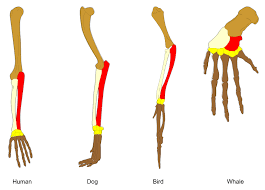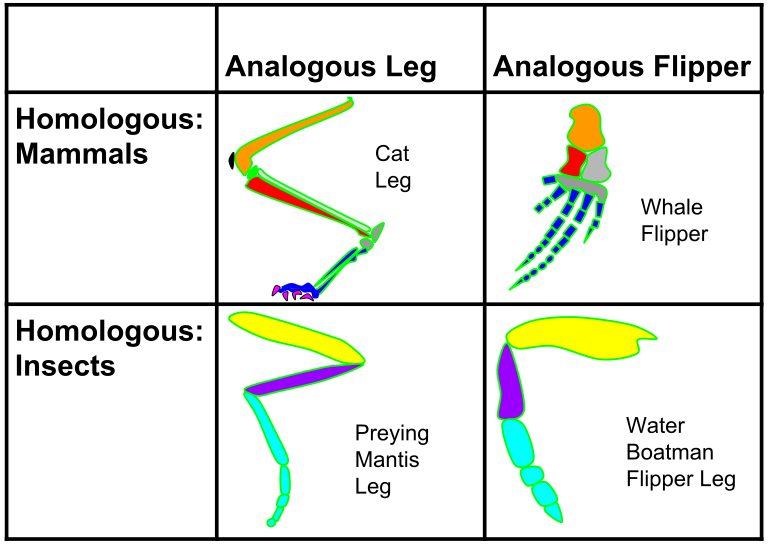Your biology teacher just finished discussing how organisms could be related based on their bone structure and common ancestry. When your teacher calls on you to explain what homologous and analogous structures are, you look up and say:

What's the difference between an analogous structure and a homologous structure? Let's dive in as to why they're important, and how they explain evolutionary history.
What are homologous structures?
Homologous structures are similar bodily features that organisms share, such as organs and bone structures. This suggests that some organisms may have evolved together and are related via common ancestry.
Although these structures appear similar, homologous structures serve different functions in each organism. These different functions help the organism adapt to its specific environment.  Image courtesy of Wikimedia Commons
Image courtesy of Wikimedia Commons
A human, dog, bird, and whale may share a homologous structure based on their bone structure. However, each organism uses these structures differently.
For example, the structure of the human arm is ideal for picking items up. The similar structure found in a dog's leg is suited for walking and standing. In birds and whales, their structures are suited for flying and swimming, respectively.
Did you know?
According to the University of California, Berkeley, homologous structures can show interesting relationships based on common ancestry!
What are analogous structures?
Analogous structures are bodily features used for the same purpose across different organisms. Organisms with these structures may not be related and could appear anatomically different. Analogous structures may have evolved based on a shared environment that forced the organism to adapt in the same way.
 Image courtesy of Wikimedia Commons
Image courtesy of Wikimedia Commons
For example, the legs of a cat and a praying mantis look different, and these organisms do not share a common ancestor. However, they serve the same function: they allow the organism to stand and travel. The same goes for the flippers of a whale and water boatman — they're unrelated yet use these limbs to swim in water.
What are the differences between homologous and analogous structures?

Homologous structures:
may appear anatomically similar across different organisms
suggests a common ancestry and shared evolutionary history
serve a different purpose in each organism
Analogous structures:
may appear anatomically different across different organisms
may not suggest a common ancestry and could be unrelated
serves the same purpose in each organism
Subscribe for more quick bites of learning delivered to your inbox.
Unsubscribe anytime. No spam. 🙂
Quiz!

You're comparing the wings of a bird and an insect. What kind of structure are the wings, and why?
A. Homologous: it serves the same purpose, and it shows common ancestry.
B. Homologous: it serves a different purpose, and it doesn't always mean they share a common ancestor.
C. Analogous: it serves the same purpose, but it doesn't always mean they share a common ancestor
D. Analogous: it serves the same purpose, and it shows common ancestry.
Quiz
You are comparing the wing of a bird and an insect. What kind of structure is the wing, and why?
Take Action

Although they sound the same, the differences between homologous and analogous structures show how complex evolutionary history can be. The main difference between these two? It's all based on whether these structures are used in the same way!
Do some research:
Your feedback matters to us.
This Byte helped me better understand the topic.
New Bytes
We publish fresh Bytes daily, we can send you a notification when that happens.
